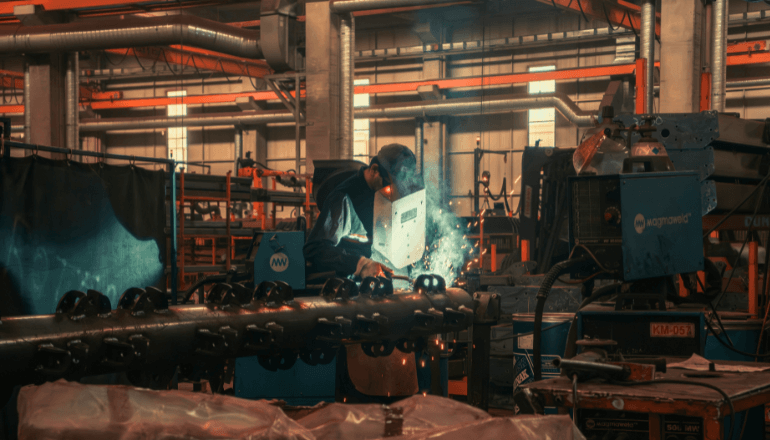Launching a new product is exciting, but choosing the right manufacturing partner can make or break your success. If you’ve ever wondered whether an OEM or ODM is the better fit, you’re not alone.
Unlike original brand manufacturers who handle end-to-end production, these manufacturing business models involve outsourcing and have significant differences in cost, design control, and competitive advantage.
In this blog post, we will clearly define both OEM and ODM. We will then delve into the pros and cons of each model, offering practical guidance to help you determine the optimal approach for your specific needs.
What is an OEM?
OEM stands for Original Equipment Manufacturer. In essence, an OEM is a company that produces goods or components based on another company’s specific designs and requirements. You, the originating company, come up with the blueprint, the technical requirements, and the quality standards, and the OEM handles the actual production process.
A classic example of OEM manufacturing in action is a company that designs its own unique smartphone but outsources the actual manufacturing of the device to a specialized electronics manufacturer. The smartphone company retains complete ownership of the phone’s design, its internal architecture, and all related intellectual property. They provide the OEM with detailed instructions on everything from the materials to be used to the precise assembly steps.
OEMs are prevalent across numerous industries requiring specialized manufacturing. This includes sectors like consumer electronics, automotive, and medical.
Here are the key characteristics that define an OEM relationship:
- You own product design and intellectual property (IP): This is a fundamental aspect. The product’s concept, design, and any associated patents belong entirely to you.
- You provide product specifications to the manufacturer: You dictate exactly how the product should be made, from the materials used to the quality control processes.
What is an ODM?
ODM stands for Original Design Manufacturer. Unlike OEM manufacturers that produce goods based on your designs, ODMs operate on a different principle. An ODM takes the initiative to design and manufacture products independently, which are then available for other companies to brand and sell under their own brand name. These are often referred as private label products.
A common example of ODM manufacturing in action is a company that wants to launch its own branded smartwatch. Instead of investing heavily in research and development to create a completely new design, they might browse the offerings of an ODM manufacturer. They select a pre-existing smartwatch design from the ODM’s catalog and then work with the ODM to add their branding, like logos and packaging.
ODMs are frequently utilized in industries where speed to market and cost efficiency are crucial. These industries commonly include fashion, home goods, and electronics manufacturing.
Here are the defining characteristics of an ODM relationship:
- Manufacturer owns the product design: The ODM partner holds the intellectual property rights to the original design of the product.
- You can request minor modifications or rebranding: While the core design belongs to the ODM, you typically have the option to add your own branding and may be able to request some limited modifications to the product’s features or appearance.
OEM vs ODM: Key Differences at a Glance
To really nail down the distinctions between these two contract manufacturing models, let’s take a look at a side-by-side comparison of the key differences between OEMs and ODMs. This should provide a clear and concise overview of what sets them apart.
| Feature | OEM | ODM |
| Product Design Ownership | Client | Manufacturer |
| Customization Level | High | Moderate to Low |
| Time to Market | Longer | Faster |
| Cost | Higher upfront | Lower upfront |
| IP Ownership | Client retains | Manufacturer retains |
| Best For | Unique, complex products | Speed, budget, simplicity |
Pros and Cons of Each Model
Now that we have a solid understanding of what OEMs and ODMs are, let’s weigh the advantages and disadvantages of each approach. The right choice for your business will ultimately depend on your specific goals, resources, and market strategy.
OEM Pros
- Full design control: With an OEM business model, you have complete authority over every aspect of your product’s design, ensuring it aligns perfectly with your vision and brand identity.
- Strong brand differentiation: By owning the unique design, you can produce products that stand out in the market and offer a distinct value proposition to your customers.
- Better IP protection: Since you own the intellectual property, you have greater control over safeguarding your designs and preventing unauthorized replication.
OEM Cons
- Higher development costs: The initial investment in research, design, and tooling can be substantial.
- Longer production timelines: Developing a product from scratch and setting up manufacturing processes can take considerable time.
- Requires expert technical input: You’ll need in-house or external expertise in product design, engineering, and manufacturing oversight.
ODM Pros
- Quick turnaround: Leveraging existing designs significantly reduces development time and speeds up your time to market.
- Lower investment needed: You can avoid the significant upfront costs associated with research, design, and tooling.
- Less technical involvement: You can rely on the ODM’s design and manufacturing expertise, requiring less in-house technical capacity.
ODM Cons
- Limited product customization: You are typically restricted to the ODM’s existing designs and may only be able to make minor modifications.
- Risk of design being shared across other clients: The ODM may offer similar or even the same product designs to other companies, potentially diluting your brand’s uniqueness.
- Less control over IP: Since the ODM owns the original design, your intellectual property rights are limited to your branding and any minor modifications you make.
How to Choose: OEM or ODM?
Deciding what kind of contract manufacturer to partner with is a strategic decision that can significantly impact your business trajectory. The ideal choice depends on a careful evaluation of several key factors specific to your circumstances and objectives. Here are some crucial aspects to consider when making this decision:
- Budget: Your financial resources will heavily influence your options. OEM services typically involve higher upfront costs for design and tooling, while ODM offers a potentially more budget-friendly entry point.
- Timeline: How quickly do you need to bring your product to market? ODM projects generally offer faster turnaround times due to their pre-existing designs.
- Product uniqueness: How important is it for your own product to be distinct and avoid being the same product offered by numerous competitors? Market research can reveal the value consumers place on unique designs. OEM allows for complete design control.
- In-house design capabilities: Do you have an internal team with the expertise to design and engineer your product? If not, an ODM might provide a more accessible path.
- Long-term brand goals: What are your aspirations for your brand? If building a strong identity based on unique, proprietary products is a key goal, OEM might be the better long-term strategy.
- Supply chain integration: Carefully consider how each model will integrate with your current operations and established supply chain infrastructure.
Real-World Examples to Guide Your Decision
To illustrate how these factors play out in real-world scenarios:
- Startups with limited capital and a need to quickly enter the market might find the ODM model more appealing. It allows them to launch products faster and with less initial investment, focusing their resources on branding and marketing.
- Established brands looking to innovate and maintain a unique product portfolio often lean towards the OEM model. This allows them to create proprietary designs, strengthen their brand differentiation, and protect their intellectual property in the long run.
How Brightpearl Supports OEM and ODM Supply Chains
Regardless of whether you choose the OEM or ODM route, efficient supply chain management is crucial for success. Brightpearl is designed to provide the robust tools and features you need to streamline your operations and optimize your workflows, no matter your chosen manufacturing model.
Here’s how Brightpearl provides end-to-end visibility and control over your entire supply chain:
Inventory and Order Management Across Multiple Suppliers
Whether you’re managing components from various OEM suppliers or finished goods from different ODMs, Brightpearl provides a centralized platform to track inventory levels, manage purchase orders, and ensure timely fulfillment across your entire network.
Demand Forecasting and Reporting
Gain valuable insights into product performance and anticipate future demand with Brightpearl’s comprehensive forecasting and reporting capabilities. This allows you to make informed purchasing decisions, whether you’re planning production with an OEM or placing orders with an ODM.
Automation and Scalability
Brightpearl automates key processes, from purchase order creation to sales order processing, reducing manual effort and minimizing errors. This scalability is essential as your business grows, whether you’re expanding your OEM production or adding new ODM product lines.
Ensuring Supply Chain Visibility and Agility
With real-time visibility into your inventory, orders, and supplier performance, Brightpearl enables you to react quickly to disruptions and optimize your supply chain for maximum efficiency and agility, regardless of your manufacturing partnerships.
Choosing Your Manufacturing Path
To quickly recap, the core difference between OMD and OEM companies lies in who owns the design. With an OEM, you hold the reins of creation and intellectual property, while an ODM offers pre-existing designs ready for your branding.
As you navigate your production strategy, remember to carefully weigh your unique business needs – your budget, timelines, desired product differentiation, and long-term brand vision will all play a crucial role in determining the most suitable path.
Ready to explore how a robust platform can power a smarter, leaner supply chain, regardless of your chosen manufacturing model? We invite you to book a demo of Brightpearl today and discover how we can help streamline your operations.




